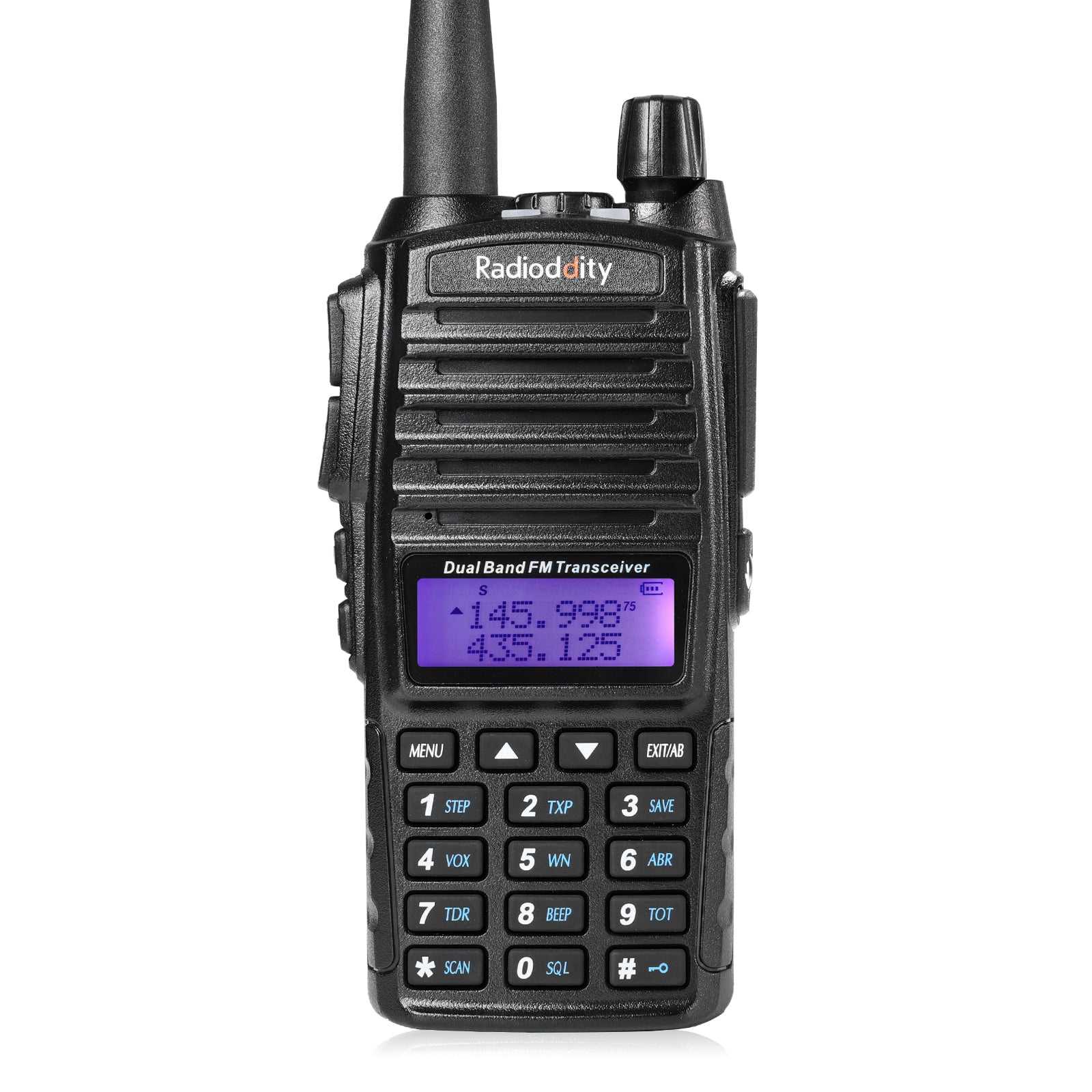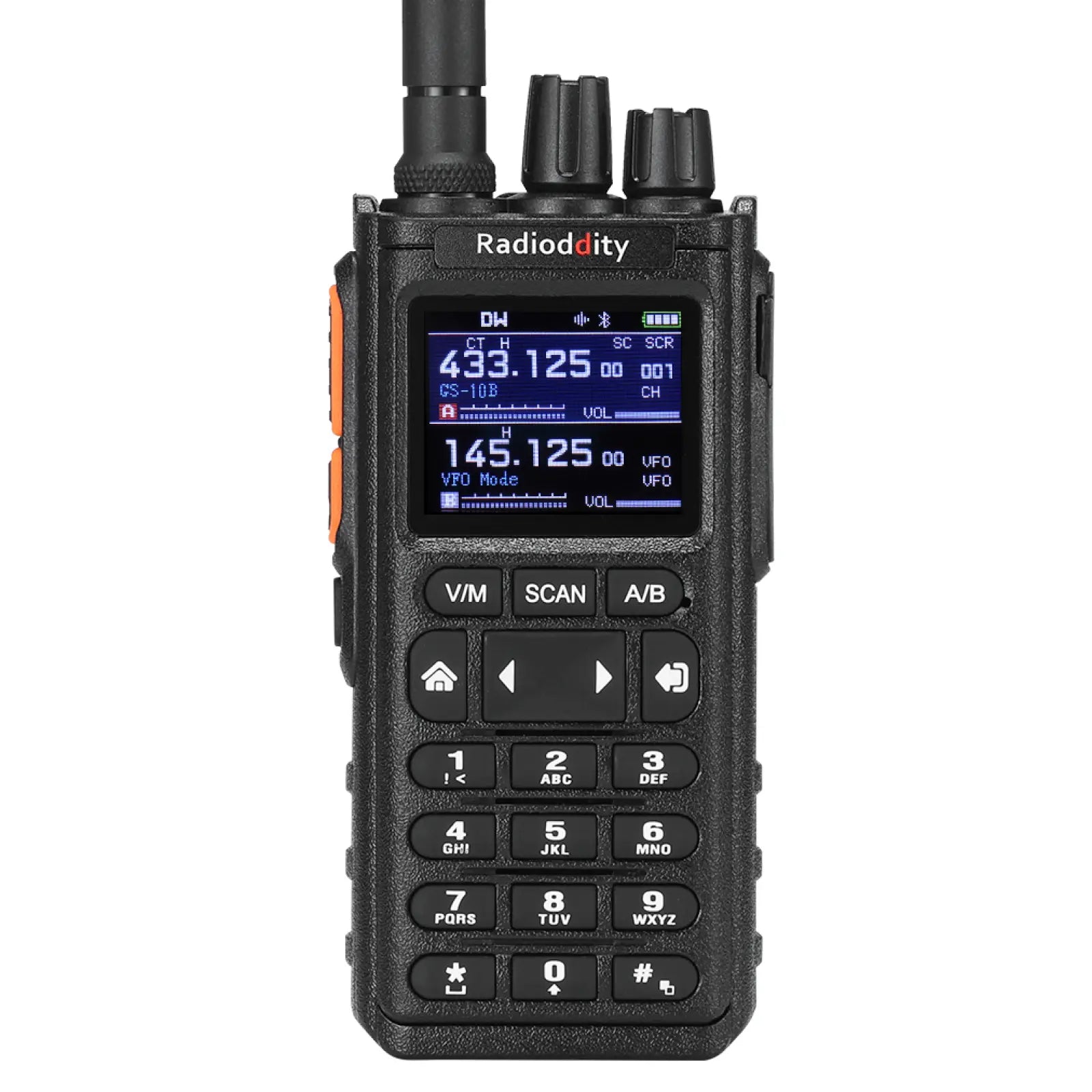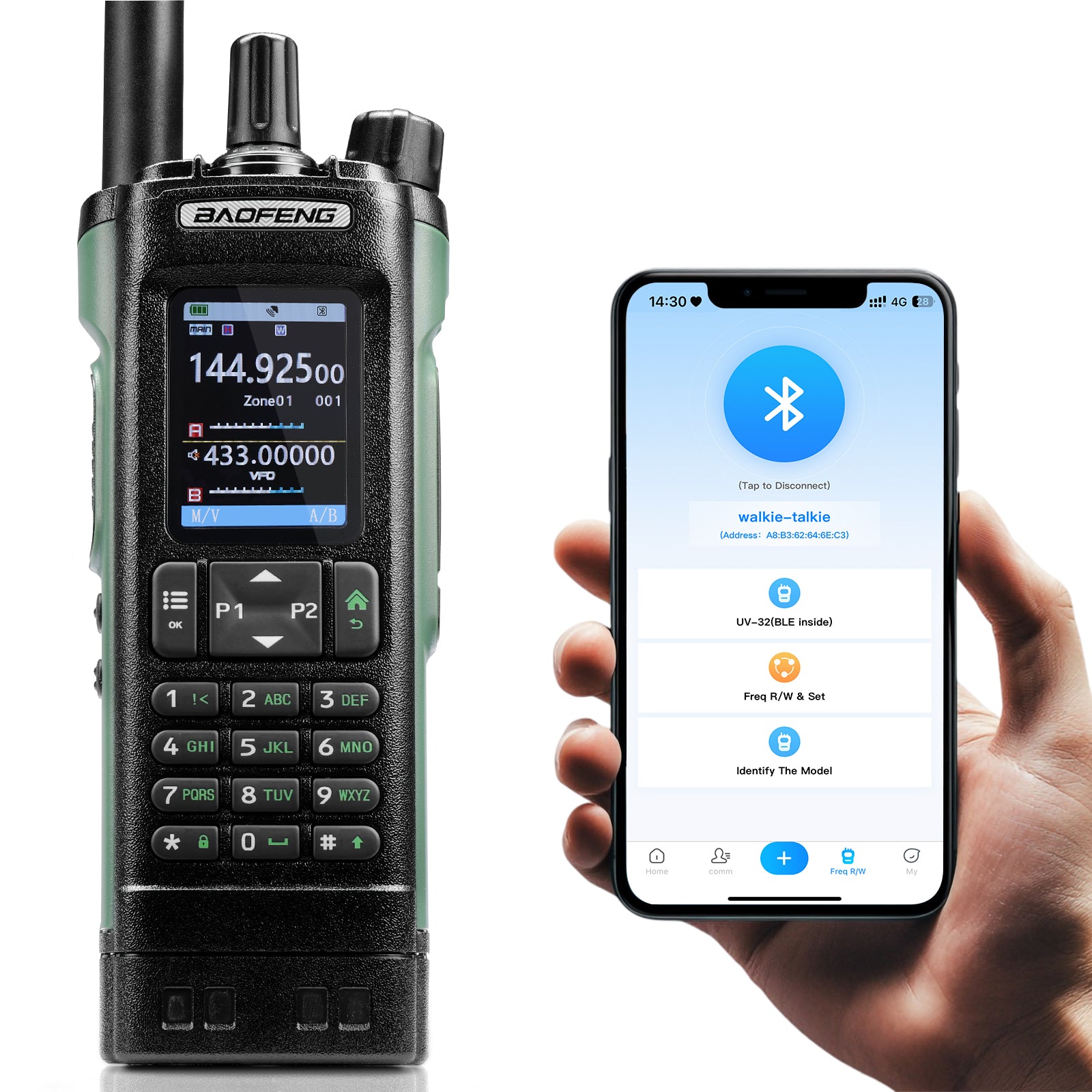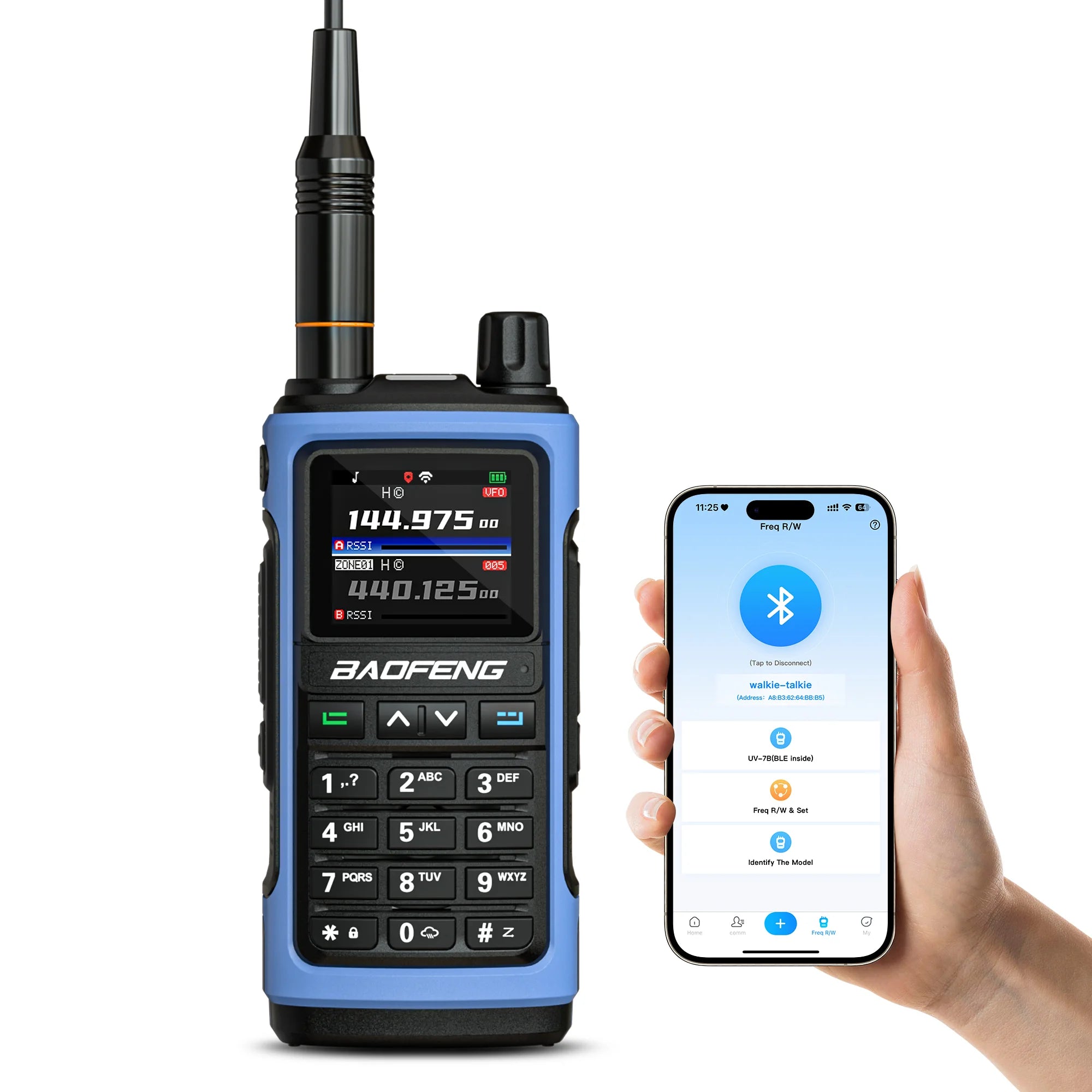Radioddity MU-5 MURS Handheld Radio
More than a MURS radio, MU-5 is also a UHF/VHF scanner and monitor and an NOAA
weather receiver. This gives you more frequency band selections and a wider
range for listening.
Little change, big help. The MU-5 utilizes some unique features, like sync
display and customizable scan range, to make it more efficient while scanning
and operating.
Why Choose MURS Radio?
The Multi-Use Radio Service (MURS) band covers the frequency range 151 – 154
MHz, with a power limit of 2 watts and limit of 5 channels. Most be used for
personal, industrial, or business radio purposes.
MURS radios don’t require a license to operate, but it is less crowded and
doesn't share frequencies with GMRS and FRS so it has far less static and
interference.
Features
VOX (hands free talking)
9 levels squelch
Flashlight
SOS Alarm

|

|

|
NOAA + Dual Band Scanning
MU-5 comes with a dual-band antenna, allowing you to receive and scan on
UHF & VHF channels in either CH or VFO modes, so you are not limited to
MURS channels. Also, it is enabled to monitor the NOAA weather band.
|
Display Sync & Dual Watch
Single watch and dual watch selectable. When turning on Sync Display in
single watch mode, you can see the channel name and frequency at the
same time for fast recognition of the channel.
In dual watch mode, you can monitor two channels simultaneously.
|
Easily Add or Remove a Channel
In most other radios you must add and remove channels via CPS
programming, but with the MU-5 you can add a new active channel to an
empty channel or replace an existing channel from the front panel.
|

|

|

|
Customizable Scan Range
Most radios scan the frequency starting from the first frequency to the
last frequency, which can take a long time to scan through completely.
On the MU-5, you can set a precise range to scan. For example, if you
want to find active channels in the range of 138MHz-145MHz, just input
138 and 145 to narrow the range and scan faster.
|
USB-C Charging Port
The MU-5 has a USB type C charging port on the battery which allows
you to recharge the battery individually or combine it with the radio
for more convenient charging.
|
Share Accessories with GM-30
The MU-5 can use most of the Radioddity GM-30’s accessories, including
the battery, belt clip, charging station, programming cable, speaker
microphone & earpiece.
*Note: MU-5 uses SMA-F antenna, which is not compatible with GM-30.
|
Specifications
Total Channels: 250
Channel 1-5: MURS channels
Channel 6-20: Extra 3 groups of MURS channels (customize channel name, CTCSS/DCS
tones available)
Channel 21-250: UHF VHF frequency (only can scanning and receiving)
NOAA Channel: 11 (Press and hold the weather button to start scanning and
receiving)
Frequency Range: 151–154 MHz
Power Output: 2W
Privacy Tones: 50 CTCSS, 210 DCS
Battery Capacity: 1500mAh
Dimension (L x H x W): 2.4" x 12.2" x 1.4"
Weight: 7.5 ounce
What's in the box?
1 x Radioddity MU-5
1 x 1500mAh Battery
1 x USB-C Charging Cable
1 x Dual Band Antenna
1 x Belt Clip
1 x Wrist Strap
1 x User Manual
1 x Adapter
1 Year and 6 months Manufacturer's Warranty.
• This warranty from Radioddity covers all new items (except Xiegu brand)
purchased from radioddity.com. For purchases made
through other platforms like Amazon, eBay, and Walmart, we offer a 1-year
warranty period from the date of purchase. The specific warranty terms may vary
depending on the authorized dealer.
• This warranty cannot be transferred. You need to provide proof of purchase
from us or an authorized dealer to avail warranty service.
• For Xiegu brand items, we offer a 1.5-year warranty for the G90, X6100, and
X5105 models starting from September 14, 2022. All other models come with a
1-year warranty.
What Does This Limited Warranty Cover?
We warrant that the Products are free from defects in materials and workmanship
under normal use and use in accordance with the respective Product user manual,
during the Warranty Period. Please refer to the Instructions inside each package
for a description of proper use and care of the unit.
What Does This Limited Warranty Not Cover?
This limited warranty does not cover damages directly or indirectly arising or
resulting from or during:
(1) accident, misuse, abuse, vandalism or acts of God (including lightning and
other weather conditions)
(2) use with another product or other damage or loss suffered by the use or
combination of any other item
(3) improper or inadequate maintenance
(4) repairs by an unauthorized service technician
(5) normal wear and tear
Open Box
Open Box items are products that have damaged packaging or are otherwise not
suitable to be sold as new. All items are tested to be working by a member of
our team.
Open Box items come with a 6-month warranty instead of the standard 18 months
warranty and are not eligible for any warranty extension offered to new
products. We will not accept returns of Open Box items due to cosmetic damage or
other non-performance-related issues. All sales of Open Box items are final and
not eligible for a return or refund.
If for some reason the item is defective on arrival, please contact
support@radioddity.com
so we can arrange a replacement.
If you are satisfied with our products and service, please kindly leave us a
positive product review. Any problem, be free to contact us
support@radioddity.com
We strive to answer all emails as quickly as possible, but due to high email
volume, it may take time for us to reply. Thanks in advance for your patience!
Order Processing
All orders are processed within 1-2 business days after we receive
your full payment, excluding weekends and holidays.
As soon as your order is ready, we’ll update the tracking number and send it to
you if you’re a Radioddity Member. We highly recommend that you register as a
Radioddity Member
here.
If the item you ordered is temporarily out of stock, our customer service team
will reach out to you. You can choose to wait until the item is back in stock or
cancel your order.
Please be aware that we have several distribution centers globally. Therefore,
your orders may be shipped from various locations including the United States,
Canada, Europe, or China, depending on the availability of the product in our
inventory.
Flat Shipping Rates
|
Country
|
US
|
EU
|
Outside US & EU
|
|
|
Free when order amount ≥ $99.99
|
Free when order amount ≥ $99.99
|
Free when order amount ≥ $99.99
|
|
Flat fee
|
$9.99
|
$9.99
|
$9.99
|
|
Ship from
|
➤ United States
➤ China
|
➤ Germany
➤ China |
➤ China
|
|
Handling time
|
1-2 business days |
1-2 business days |
1-2 business days |
|
Delivery time
|
5-7 business days
|
5-7 business days
|
7-15 business days
|
Note:
1. Customs fee included for US & EU countries.
2. Please note that taxes will be applied to shipping rates. These taxes will
be calculated and added to your total at checkout.
3. US Shipping does not include Alaska, Hawaii and Puerto Rico area.
Please contact us for a detailed shipping fee to these areas.
4. For EU countries, please be aware that the listed product prices do not
include VAT.
5. For shipping options to other countries, please visit our
EXPANDED INTERNATIONAL SHIPPING page.
6. Please be aware that for outlet items, pre-orders, and open box items, the
shipping services and charges may vary.
How Do I Change The Shipping Address Or Cancel My Order
Contact support@radioddity.com (CLICK HERE) immediately if you need to change the shipping address or cancel your order. Please be advised that some orders are shipped very soon after placement and it will not always be possible to make changes to the shipping address and/or cancel the order.
Frequently Asked Questions
1. What forms of payment do you accept?
Radioddity.com currently accepts PayPal* or credit card for all orders.
*When purchasing with PayPal, your shipping address will automatically default to the address on file with PayPal, regardless of the shipping address you enter on your Radioddity.com order.
2. Why has my credit card payment failed?
Payment with a credit card may fail because of bank authorization and fraud prevention systems. If you are having trouble making a payment via Credit Card, you may contact your card issuing bank or PayPal directly. Here are PayPal's phone numbers:
+1-888-221-1161 (US & Canada Toll Free) +1-888-215-5506 (US & Canada Toll Free)
+1-402-935-7733 (International) +1-402-935-2050 (International)
3. How do I know if it is safe to shop with you?
Radioddity.com takes great pride in offering a safe and secure online shopping experience. We also respect your privacy and we're committed to protecting it.
4. Is there any discount for bulk/volume purchases?
Radioddity does provide discounts for some bulk/volume purchases. Please email our customer service for more details.
5. Do you ship internationally?
Yes, we do! We ship to US & EU countries. For some products, we ship to CA.
6. How can I contact Radioddity.com for additional assistance?
Email Customer service:
please email us via support@radioddity.com, and we will respond to your email as quickly as possible, usually within 24-48 hours.
7. How are warranties handled?
Repairs on defective merchandise are handled by the manufacturers and not by Radioddity unless otherwise indicated. If any item arrives damaged due to shipping, immediately contact the courier. Keep all shipping materials and contact us immediately.
8. Why didn't I receive an order confirmation email after my PayPal payment is completed?
We send a confirmation email to your primary PayPal email address or the e-mail address you have specified if you used the "PayPal Express Checkout" method. Make sure that you have a Radioddity account registered under your PayPal account's primary e-mail address.
In rare circumstances, a technical bug confirmed by PayPal can get in the way. If you do not receive any information at all, and your order does not appear in your Radioddity account, please contact us and send us your order details.
9. How do I change the shipping address or cancel my order?
Please contact customer service immediately if you need to change the shipping address or cancel your order. Please be advised that some orders are shipped very soon after payment and it will not always be possible to make changes to the shipping address and/or cancel the order.
10. What does Radioddity.com charge for shipping order and how long will it be before I receive my order?
Please CLICK HERE to
learn about our shipping policy.
11. Do you ship to PO boxes or Military APO/FPO addresses?
Only USPS can ship to both PO Boxes and Military APO/FPO addresses. The items have to be less than 2kg. Please allow additional time for orders to be shipped to these addresses. Express shipping cannot be sent to both PO Boxes and Military APO/FPO addresses.
12. Why am I unable to track my order?
It can sometimes take 24-48 hours or so for tracking information to update once an order has shipped from our warehouse.
Occasionally, a package may not receive the proper origin and transit scans while on its journey to you, so neither us nor express is able to track the exact location of the package in transit.
Please email us if you do not receive your order by the end of the quoted time frame. Please note that orders shipping via UPS can be delivered as late as 9:00 pm local time in some areas.
13. Taxes, Customs, & Duties
If the package is checked by your country's customs office when the item arrives in your country, most websites are declaring that you are responsible for import duties, tariffs, and taxes. However, Radioddity will be happy to go fifty-fifty with customers. Quality customer service is our highest value and we try our best to reduce our customer’s loss.
14. How do I return products if I am unsatisfied?
Please CLICK HERE to
learn about our return policy.
15. What do I do if received the wrong item?
Return the wrong item. If the item you received is completely different from the one you ordered, please contact our Customer Service with photos or videos of the different product. If a return is necessary, replacement plus return shipping cost will be issued to you on receiving the returned product. Or if you decide to keep it, we will offer a 10% discount for buying it.
16. How do I return defective items?
If your product turns out to be a defective one with physical damage within 30 days from the initial receiving date. You can mail the item back in the original package without any wear and tear for a free replacement. However, you will need to provide photos and videos showing the defect(s) of the product.
*NOTE: We strongly recommend obtaining and saving your return tracking number until you are notified that we have completed your refund.*
17. When will a replacement be sent?
Replacements are treated the same way as that of new orders -- they typically arrive in 10 to 13 days. If a product needs to be returned for replacement, the replacement is sent after receiving the returned item.
18. How long does it take for me to get a refund?
It may take 1 or 2 weeks for your return to reach our warehouse. Once it is received and inspected (usually within 72 hours of arrival) your refund will be processed and automatically applied to your credit card or original method of payment within 2 days. Please note that depending on your credit card company, it may take additional 2-10 business days after your credit is applied for it to post to your account.
![Radioddity GD-168 [OPEN BOX] - Radioddity](http://radioddity.myshopify.com/cdn/shop/files/GD-168_1600x1600_3922a234-2fe4-4b80-8282-3f6d17a10d71.png?v=1762470234)

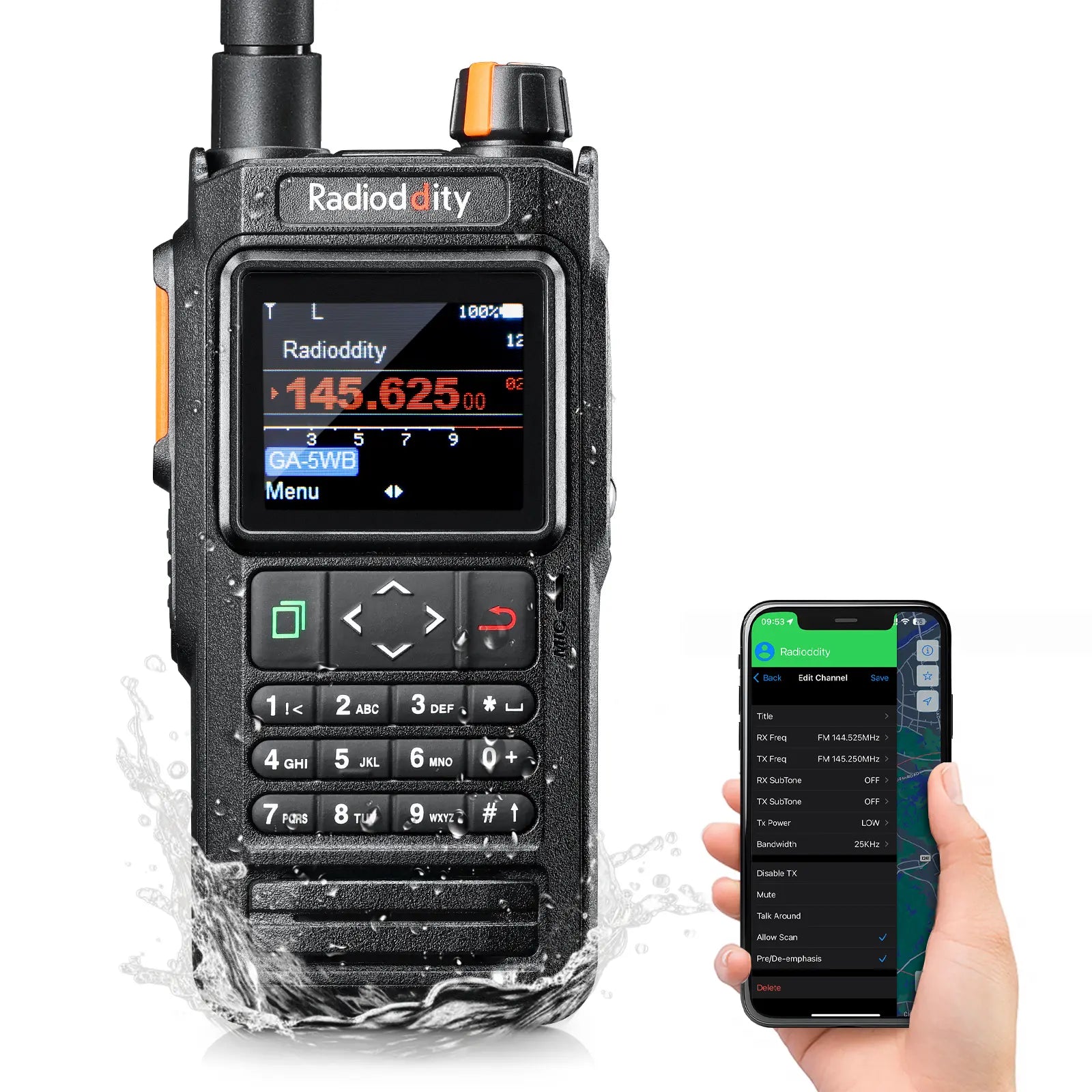








![Baofeng GT-5R 5W Dual Band Radio [Upgraded Legal Version of UV-5R] - Radioddity](http://radioddity.myshopify.com/cdn/shop/products/GT-5RImage.png?v=1762459898)
![Baofeng UV-5R PLUS [5 Colors] | DUAL BAND | 4/1W | 128CH | FLASHLIGHT - Radioddity](http://radioddity.myshopify.com/cdn/shop/products/3_58c037e1-560a-4c85-bd75-67c202269d29.jpg?v=1762457615)










![GA-2S UHF Long Range USB Two way Radio [2/4/6 Packs] - Radioddity](http://radioddity.myshopify.com/cdn/shop/products/5_96d2d28c-8609-4f29-926b-d423141df2f4.jpg?v=1762457835)



![Baofeng BF-888S [2 Pack] | UHF | 5W | 16CH | CTCSS/DCS | Flashlight - Radioddity](http://radioddity.myshopify.com/cdn/shop/products/1___1___1.jpg?v=1762457605)
![Baofeng GT-1 [2 Pack] | UHF | 5W | 16CH | Flashlight | FM Function Two-Way Radio - Radioddity](http://radioddity.myshopify.com/cdn/shop/products/ia_100000006122.jpg?v=1762457668)


